Jurassic Igneous Activity in the Yuseong Area on the Southern Margin of the Gyeonggi Massif, Korean Peninsula, and Its Implications for the Tectonic Evolution of Northeast Asia during the Jurassic
Abstract
1. Introduction
2. General Geology and Petrography
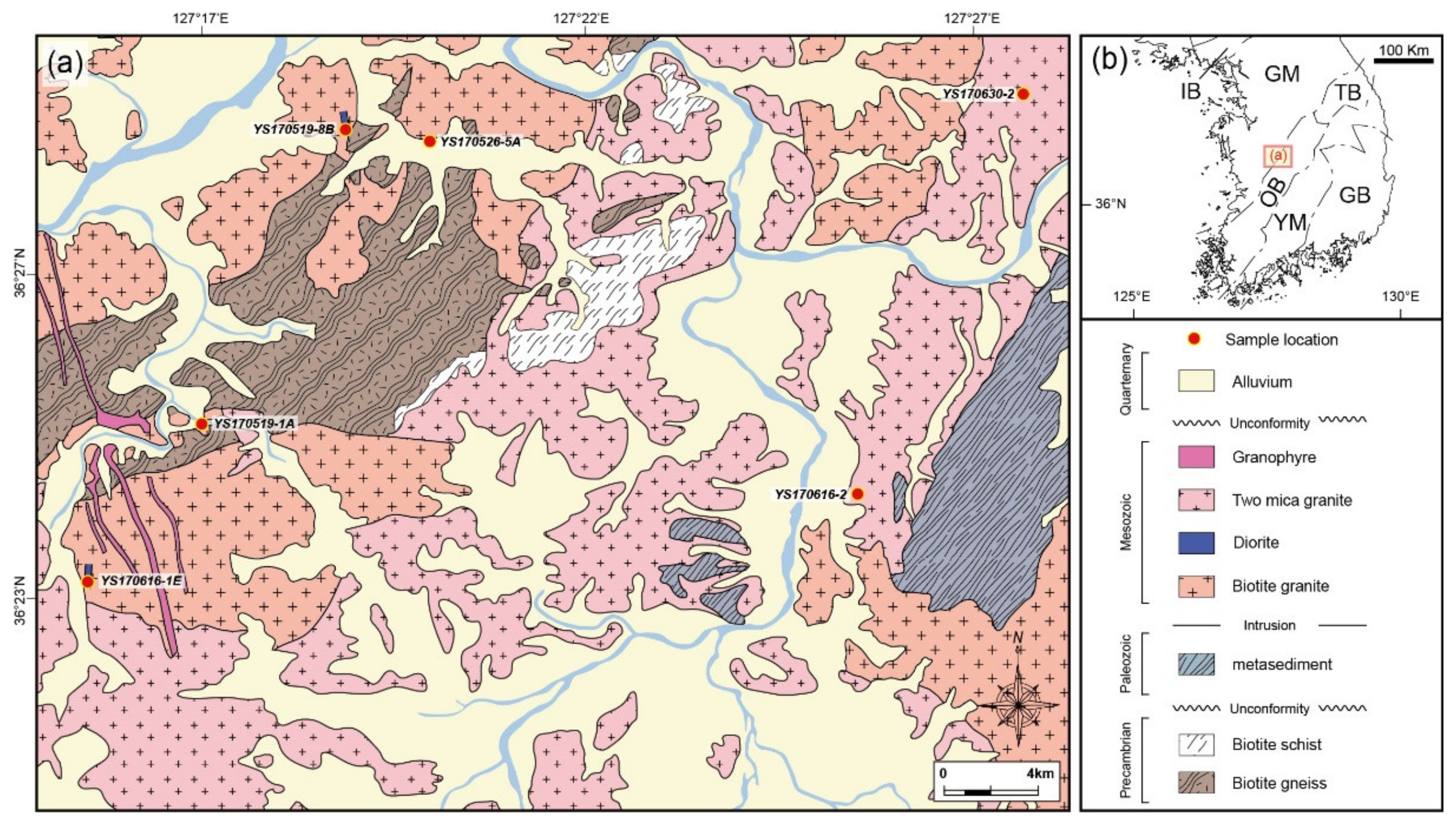
3. Analytical Methods
4. Results
4.1. Geochronology
4.2. Whole-Rock Geochemistry
5. Discussion
5.1. Petrogenesis of the Jurassic Diorite in the Yuseong Area and the YM
5.2. Petrogenesis of the Jurassic Granite in the Yuseong Area and YM
5.3. The Regional Evolution of the Subduction Process in Northeast Asia during the Jurassic
6. Conclusions
- (1)
- The Jurassic igneous rocks in the Yuseong area consist of diorite and granitoids, and they formed at 177–178 Ma and 168–169 Ma, indicating that there were two stages of igneous activity in the Yuseong area during the Jurassic.
- (2)
- The Jurassic diorite has geochemical characteristics that are representative of a volcanic arc tectonic setting. The geochemical characteristics of the Jurassic granitoids indicate two tectonic environments: a volcanic arc, and a syncollisional environment. The syncollisional character is not correct because it resulted from strong fractionation of plagioclase and alkali feldspar from the parental magma, which formed in a volcanic arc tectonic setting. These data indicate that the Jurassic igneous rocks in the study area intruded in an arc tectonic setting.
- (3)
- The Jurassic diorites originated from an E-MORB-type mantle source, and have relatively high Th/Yb ratios of 8.0–5.5, indicating that they underwent 10–20% crustal contamination during magma ascent. The Jurassic I-type granodiorite that formed at 178 Ma originated from basalt-derived melt, with 10% mixing of pelite-derived melt, and the I-type quartz monzonite that intruded at 168 Ma formed from basalt-derived melt that mixed with approximately 40% pelite-derived melt. The Jurassic S-type granite in the Yuseong area was formed from a pelite-derived melt source.
- (4)
- Flat subduction began to occur at 175 Ma under the northern Asian continent, and continued until 140 Ma.
Supplementary Materials
Author Contributions
Funding
Data Availability Statement
Acknowledgments
Conflicts of Interest
References
- Kee, W.-S.; Kim, S.W.; Jeong, Y.J.; Kwon, S. Characteristics of Jurassic continental arc magmatism in South Korea: Tec-tonic implications. J. Geol. 2010, 118, 305–323. [Google Scholar] [CrossRef]
- Kim, S.W.; Oh, C.W.; Choi, S.G.; Ryu, I.C.; Itaya, T. Ridge subduction-related Jurassic plutonism in and around the Ok-cheon metamorphic belt, South Korea, and implication ofr northeast Asian tectonics. Int. Geol. Rev. 2005, 47, 248–269. [Google Scholar] [CrossRef]
- Kim, S.W.; Kwon, S.; Ko, K.; Yi, K.; Cho, D.-L.; Kee, W.-S.; Kim, B.C. Geochronological and geochemical implications of Early to Middle Jurassic continental adakitic arc magmatism in the Korean Peninsula. Lithos 2015, 227, 225–240. [Google Scholar] [CrossRef]
- Park, K.H.; Kim, M.J.; Yang, Y.S.; Cho, K.O. Age distribution of the Jurassic plutons in Korean peninsula. J. Petrol. Soc. Korea 2010, 19, 269–281, (In Korean with English Abstract). [Google Scholar]
- Sagong, H.; Kwon, S.-T.; Ree, J.-H. Mesozoic episodic magmatism in South Korea and its tectonic implication. Tectonics 2005, 24, 24. [Google Scholar] [CrossRef]
- Cheong, A.C.S.; Jo, H.J. Tectonomagmatic evolution of a Jurassic Cordilleran flare-up along the Korean Peninsula: Geo-chronological and geochemical constraints from granitoid rocks. Gondwana Res. 2020, 88, 21–44. [Google Scholar] [CrossRef]
- Kagami, H.; Yuhara, M.; Tainosho, Y.; Iizumi, S.; Owada, M.; Hayama, Y. Sm-Nd isochron ages of mafic igneous rocks from the Ryoke Belt, Southwest Japan: Remains of Jurassic igneous activity in a late Cretaceous granitic terrane. Geochem. J. 1995, 29, 123–135. [Google Scholar] [CrossRef]
- Takahashi, Y.; Cho, D.L.; Kee, W.S. Timing of mylonitization in the Funatsu Shear Zone within Hida Belt of southwest Japan: Implications for correlation with the shear zones around the Okcheon Belt in the Korean Peninsula. Gondwana Res. 2010, 17, 102–115. [Google Scholar] [CrossRef]
- Wu, F.-Y.; Sun, D.-Y.; Ge, W.-C.; Zhang, Y.-B.; Grant, M.L.; Wilde, S.A.; Jahn, B.-M. Geochronology of the Phanerozoic granitoids in northeastern China. J. Asian Earth Sci. 2011, 41, 1–30. [Google Scholar] [CrossRef]
- Wu, F.-Y.; Yang, J.-H.; Xu, Y.-G.; Wilde, S.A.; Walker, R.J. Destruction of the North China Craton in the Mesozoic. Annu. Rev. Earth Planet. Sci. 2019, 47, 173–195. [Google Scholar] [CrossRef]
- Yang, W.; Li, S. Geochronology and geochemistry of the Mesozoic volcanic rocks in Western Liaoning: Implications for lithospheric thinning of the North China Craton. Lithos 2008, 102, 88–117. [Google Scholar] [CrossRef]
- Zhai, M.; Zhang, Y.; Zhang, X.; Wu, F.; Peng, P.; Li, Q.; Hou, Q.; Li, T.; Zhao, L. Renewed profile of the Mesozoic mag-matism in Korean Peninsula: Regional correlation and broader implication for cratonic destruction in the North China Craton. Sci. China Earth Sci. 2016, 59, 2355–2388. [Google Scholar] [CrossRef]
- Zhang, J.-H.; Gao, S.; Ge, W.-C.; Wu, F.-Y.; Yang, J.-H.; Wilde, S.A.; Li, M. Geochronology of the Mesozoic volcanic rocks in the Great Xing’an Range, northeastern China: Implications for subduction-induced delamination. Chem. Geol. 2010, 276, 144–165. [Google Scholar] [CrossRef]
- Paek, R.J.; Ju, Y.J. Tectonic division of Korean peninsula. In Geology of Korea; Foreign Languages Books Publishing House Pyongyang: Pyongyang, Korea, 1996; pp. 483–507. [Google Scholar]
- Oh, C.W.; Kusky, T. The Late Permian to Triassic Hongseong-Odesan Collision Belt in South Korea, and Its Tectonic Correlation with China and Japan. Int. Geol. Rev. 2007, 49, 636–657. [Google Scholar] [CrossRef]
- Oh, C.W.; Kim, S.W.; Ryu, I.C.; Okada, T.; Hyodo, H.; Itaya, T. Tectono-metamorphic evolution of the Okcheon meta-morphic belt, South Korea: Tectonic implications in East Asia. Isl. Arc 2004, 13, 387–402. [Google Scholar] [CrossRef]
- Zhou, X.; Sun, T.; Shen, W.; Shu, L.; Niu, A.Y. Petrogenesis of Mesozoic granitoids and volcanic rocks in South China: A response to tectonic evolution. Episodes 2006, 29, 26–33. [Google Scholar] [CrossRef] [PubMed]
- Li, X.H.; Li, Z.X.; Li, W.X.; Liu, Y.; Yuan, C.; Wei, G.; Qi, C. U–Pb zircon, geochemical and Sr–Nd–Hf isotopic con-straints on age and origin of Jurassic I-and A-type granites from central Guangdong, SE China: A major igneous event in response to foundering of a subducted flat-slab? Lithos 2007, 96, 186–204. [Google Scholar] [CrossRef]
- Li, Z.X.; Li, X.H. Formation of the 1300-km-wide intracontinental orogen and postorogenic magmatic province in Mes-ozoic South China: A flat-slab subduction model. Geology 2007, 35, 179–182. [Google Scholar] [CrossRef]
- Zhou, X.M.; Li, W.X. Origin of Late Mesozoic igneous rocks in Southeastern China: Implications for lithosphere subduc-tion and underplating of mafic magmas. Tectonophysics 2000, 326, 269–287. [Google Scholar] [CrossRef]
- Zhu, K.-Y.; Li, Z.-X.; Xu, X.-S.; Wilde, S.A.; Chen, H.-L. Early Mesozoic ferroan (A-type) and magnesian granitoids in eastern South China: Tracing the influence of flat-slab subduction at the western Pacific margin. Lithos 2016, 240–243, 371–381. [Google Scholar] [CrossRef]
- Keevil, H.A.; Monecke, T.; Goldfarb, R.J.; Möller, A.; Kelly, N.M. Geochronology and geochemistry of Mesozoic igneous rocks of the Hunjiang basin, Jilin Province, NE China: Constraints on regional tectonic processes and lithospheric de-lamination of the eastern North China block. Gondwana Res. 2019, 68, 127–157. [Google Scholar] [CrossRef]
- Egawa, K.; Itoh, Y. East Asia-wide flat slab subduction and Jurassic synorogenic basin evolution in west Korea. In Mecha-Nism of Sedimentary Basin Formation—Multidisciplinary Approach on Active Plate Margins; INTECH: London, UK, 2013; pp. 63–81. [Google Scholar]
- Kiminami, K.; Kishita, S.; Imaoka, T. Marked change in sandstone composition during the Middle Jurassic in Jurassic ac-cretionary complexes of SW Japan, and geologic significance. J. Geol. Soc. Jpn. 2009, 115, 578–596, (In Japanese with English Abstract). [Google Scholar] [CrossRef][Green Version]
- Deng, J.; Su, S.; Niu, Y.; Liu, C.; Zhao, G.; Zhao, X.; Zhou, S.; Wu, Z. A possible model for the lithospheric thinning of North China Craton: Evidence from the Yanshanian (Jura-Cretaceous) magmatism and tectonism. Lithos 2007, 96, 22–35. [Google Scholar] [CrossRef]
- Park, H.I.; Lee, J.D.; Cheong, J.G. Geological Report of the Yuseong Sheet (1:50,000); Korea Institute of Geoscience and Mineral Resources: Daejeon, Korea, 1977; p. 45. [Google Scholar]
- Condie, K.C. High field strength element ratios in Archean basalts: A window to evolving sources of mantle plumes? Lithos 2005, 79, 491–504. [Google Scholar] [CrossRef]
- Lee, S.R.; Lee, B.J.; Cho, D.L.; Kee, W.-S.; Koh, H.J.; Kim, B.C.; Song, K.Y.; Hang, J.H.; Choi, B.Y. SHRIMP U-Pb Zircon Age from Granitic Rocks in Jeonju Shear Zone: Implications for the Age of the Honam Shear Zone [abs.]: Abstract Volume for Proceedings of the Annual Joint Conference, Mineralogical Society of Korea and Petrological Society of Korea; Korea Institute of Geoscience and Mineral Resources: Daejeon, Korea, 2003; p. 55. Available online: http://kiss.kstudy.com/thesis/thesis-view.asp?key=3328195 (accessed on 15 March 2021).
- Cheong, C.S.; Kee, W.-S.; Jeong, Y.-J.; Jeong, G.Y. Multiple deformations along the Honam shear zone in southwestern Korea constrained by Rb-Sr dating of synkinematic fabrics: Implications for the Mesozoic tectonic evolution of northeast-ern Asia. Lithos 2006, 87, 289–299. [Google Scholar] [CrossRef]
- Kim, S.W.; Kwon, S.; Ryu, I.-C. Geochronological constraints on multiple deformations of the Honam Shear Zone, South Korea and its tectonic implication. Gondwana Res. 2009, 16, 82–89. [Google Scholar] [CrossRef]
- Watson, E.B.; Harrison, T.M. Zircon saturation revisited: Temperature and composition effects in a variety of crustal magma types. Earth Planet. Sci. Lett. 1983, 64, 295–304. [Google Scholar] [CrossRef]
- Stacey, J.; Kramers, J. Approximation of terrestrial lead isotope evolution by a two-stage model. Earth Planet. Sci. Lett. 1975, 26, 207–221. [Google Scholar] [CrossRef]
- Middlemost, E.A. Naming materials in the magma/igneous rock system. Earth-Sci. Rev. 1994, 37, 215–224. [Google Scholar] [CrossRef]
- Irvine, T.N.; Baragar, W.R.A. A Guide to the Chemical Classification of the Common Volcanic Rocks. Can. J. Earth Sci. 1971, 8, 523–548. [Google Scholar] [CrossRef]
- Peccerillo, A.; Taylor, S.R. Geochemistry of eocene calc-alkaline volcanic rocks from the Kastamonu area, Northern Turkey. Contrib. Miner. Pet. 1976, 58, 63–81. [Google Scholar] [CrossRef]
- Maniar, P.D.; Piccoli, P.M. Tectonic discrimination of granitoids. GSA Bull. 1989, 101, 635–643. [Google Scholar] [CrossRef]
- Wood, D.A. The application of a ThHfTa diagram to problems of tectonomagmatic classification and to establishing the nature of crustal contamination of basaltic lavas of the British Tertiary Volcanic Province. Earth Planet. Sci. Lett. 1980, 50, 11–30. [Google Scholar] [CrossRef]
- Green, N.L. Influence of slab thermal structure on basalt source regions and melting conditions: REE and HFSE con-straints from the Garibaldi volcanic belt, northern Cascadia subduction system. Lithos 2006, 87, 23–49. [Google Scholar] [CrossRef]
- Pearce, J.A.; Harris, N.B.W.; Tindle, A.G. Trace element discrimination diagrams for the tectonic interpretation of granit-ic rocks. J. Petrol. 1984, 25, 956–983. [Google Scholar] [CrossRef]
- Müller, D.; Franz, L.; Herzig, P.M.; Hunt, S. Potassic igneous rocks from the vicinity of epithermal gold mineralization, Lihir Island, Papua New Guinea. Lithos 2001, 57, 163–186. [Google Scholar] [CrossRef]
- Whalen, J.B.; Currie, K.L.; Chappell, B.W. A-type granites: Geochemical characteristics, discrimination and petrogene-sis. Contrib. Mineral. Petrol. 1987, 95, 407–419. [Google Scholar] [CrossRef]
- Wu, F.; Liu, X.; Ji, W.; Wang, J.; Yang, L. Highly fractionated granites: Recognition and research. Sci. China Earth Sci. 2017, 60, 1201–1219. [Google Scholar] [CrossRef]
- McDonough, W.; Sun, S.-S. The composition of the Earth. Chem. Geol. 1995, 120, 223–253. [Google Scholar] [CrossRef]
- Xia, L.; Li, X. Basalt geochemistry as a diagnostic indicator of tectonic setting. Gondwana Res. 2019, 65, 43–67. [Google Scholar] [CrossRef]
- Zhang, H.; Wu, G.-H.; Cheng, H.; Ye, R.-S.; He, J.-F.; Chen, F. Late Triassic high Mg diorites of the Wulong pluton in the South Qinling Belt, China: Petrogenesis and implications for crust-mantle interaction. Lithos 2019, 332–333, 135–146. [Google Scholar] [CrossRef]
- Yan, H.; Long, X.; Wang, X.C.; Li, J.; Wang, Q.; Yuan, C.; Sun, M. Middle Jurassic MORB-type gabbro, high-Mg diorite, calc-alkaline diorite and granodiorite in the Ando area, central Tibet: Evidence for a slab roll-back of the Ban-gong-Nujiang Ocean. Lithos 2016, 264, 315–328. [Google Scholar] [CrossRef]
- Lu, Y.-J.; Loucks, R.R.; Fiorentini, M.L.; Yang, Z.-M.; Hou, Z.-Q. Fluid fluxmelting generated postcollisional high Sr/Y copper ore-forming water-rich magmas in Tibet. Geol. Soc. Am. 2015, 43, 583–586. [Google Scholar]
- Jowitt, S.M.; Ernst, R.E. Geochemical assessment of the metallogenic potential of Proterozoic LIPs of Canada. Lithos 2013, 174, 291–307. [Google Scholar] [CrossRef]
- Lee, B.C.; Oh, C.W.; Yi, K. Geochemistry, zircon U–Pb ages, and Hf isotopic compositions of Precambrian gneisses in the Wonju–Jechon area of the southern Gyeonggi Massif: Implications for the Precambrian tectonic evolution of Korea and northeast Asia. Precambrian Res. 2016, 283, 169–189. [Google Scholar] [CrossRef]
- Plank, T.; Langmuir, C.H. The chemical composition of subducting sediment and its consequences for the crust and mantle. Chem. Geol. 1998, 145, 325–394. [Google Scholar] [CrossRef]
- Douce, A.E.P. What do experiments tell us about the relative contributions of crust and mantle to the origin of granitic magmas? Geol. Soc. Lond. Spéc. Publ. 1999, 168, 55–75. [Google Scholar] [CrossRef]
- Douce, A.E.P.; Harris, N. Experimental constraints on Himalayan anataxis. J. Petrol. 1998, 39, 689–710. [Google Scholar] [CrossRef]
- Sylvester, P.J. Post-collisional strongly peraluminous granites. Lithos 1998, 45, 29–44. [Google Scholar] [CrossRef]
- Hanson, G.N. The application of trace elements to the petrogenesis of igneous rocks of granitic composition. Earth Planet. Sci. Lett. 1978, 38, 26–43. [Google Scholar] [CrossRef]
- Chappell, B.W.; Bryant, C.J.; Wyborn, D. Peraluminous I-type granites. Lithos 2012, 153, 142–153. [Google Scholar] [CrossRef]
- Fang, Y.; Zhang, Y.-H.; Zhang, S.-T.; Cao, H.-W.; Zou, H.; Dong, J.-H. Early Cretaceous I-type granites in the Tengchong terrane: New constraints on the late Mesozoic tectonic evolution of southwestern China. Geosci. Front. 2018, 9, 459–470. [Google Scholar] [CrossRef]
- Zhu, R.-Z.; Lai, S.-C.; Qin, J.-F.; Zhao, S.-W. Early-Cretaceous highly fractionated I-type granites from the northern Tengchong block, western Yunnan, SW China: Petrogenesis and tectonic implications. J. Asian Earth Sci. 2015, 100, 145–163. [Google Scholar] [CrossRef]
- Wang, G.-C.; Jiang, Y.-H.; Liu, Z.; Ni, C.-Y.; Qing, L.; Zhang, Q.; Zhu, S.-Q. Multiple origins for the Middle Jurassic to Early Cretaceous high-K calc-alkaline I-type granites in northwestern Fujian province, SE China and tectonic implications. Lithos 2016, 246-247, 197–211. [Google Scholar] [CrossRef]
- Zhao, J.L.; Qiu, J.S.; Liu, L.; Wang, R.Q. The Late Cretaceous I- and A-type granite association of southeast China: Im-plications for the origin and evolution of post-collisional extensional magmatism. Lithos 2016, 240, 16–33. [Google Scholar] [CrossRef]
- Rapp, R.P.; Watson, E.B. Dehydration Melting of Metabasalt at 8-32 kbar: Implications for Continental Growth and Crust-Mantle Recycling. J. Petrol. 1995, 36, 891–931. [Google Scholar] [CrossRef]
- Park, S.-I.; Noh, J.; Cheong, H.J.; Kwon, S.; Song, Y.; Kim, S.W.; Santosh, M. Inversion of two-phase extensional basin systems during subduction of the Paleo-Pacific Plate in the SW Korean Peninsula: Implication for the Mesozoic “Laramide-style” orogeny along East Asian continental margin. Geosci. Front. 2019, 10, 909–925. [Google Scholar] [CrossRef]
- Deng, J.; Su, S.; Mo, X.; Zhao, G.; Xiao, Q.; Ji, G.; Qiu, R.; Zhao, H.; Luo, Z.; Qans, Y.; et al. The sequence of magmat-ic-tectonic events and orogenic processes of Yanshan belt, North China. Acta Geol. Sin. 2004, 78, 260–266. [Google Scholar]
- Yamada, R.; Sawada, H.; Aoyama, S.; Ouchi, W.; Niki, S.; Nagata, M.; Takahashi, T.; Hirata, T. Zircon U–Pb ages and whole–rock geochemistry from the Hida granites: Implications for the geotectonic history and the origin of Mesozoic granites in the Hida belt, Japan. J. Miner. Petrol. Sci. 2021, 116, 61–66. [Google Scholar] [CrossRef]
- Chen, W.J.; Zhou, X.H.; Li, Q.; Yang, J.H.; Li, D.M.; Chen, S.H.; Zheng, D.W.; Wan, J.Q.; Zhang, G.H.; Wang, F. Research on Mesozoic volcanic chronology, geochemistry and tectonic settings around the Liaohe River. In Internal Report of the Institute of Geology, Seismological Bureau of China; China Earthquake Administration (CEA): Beijing, China, 1999. (In Chinese) [Google Scholar]
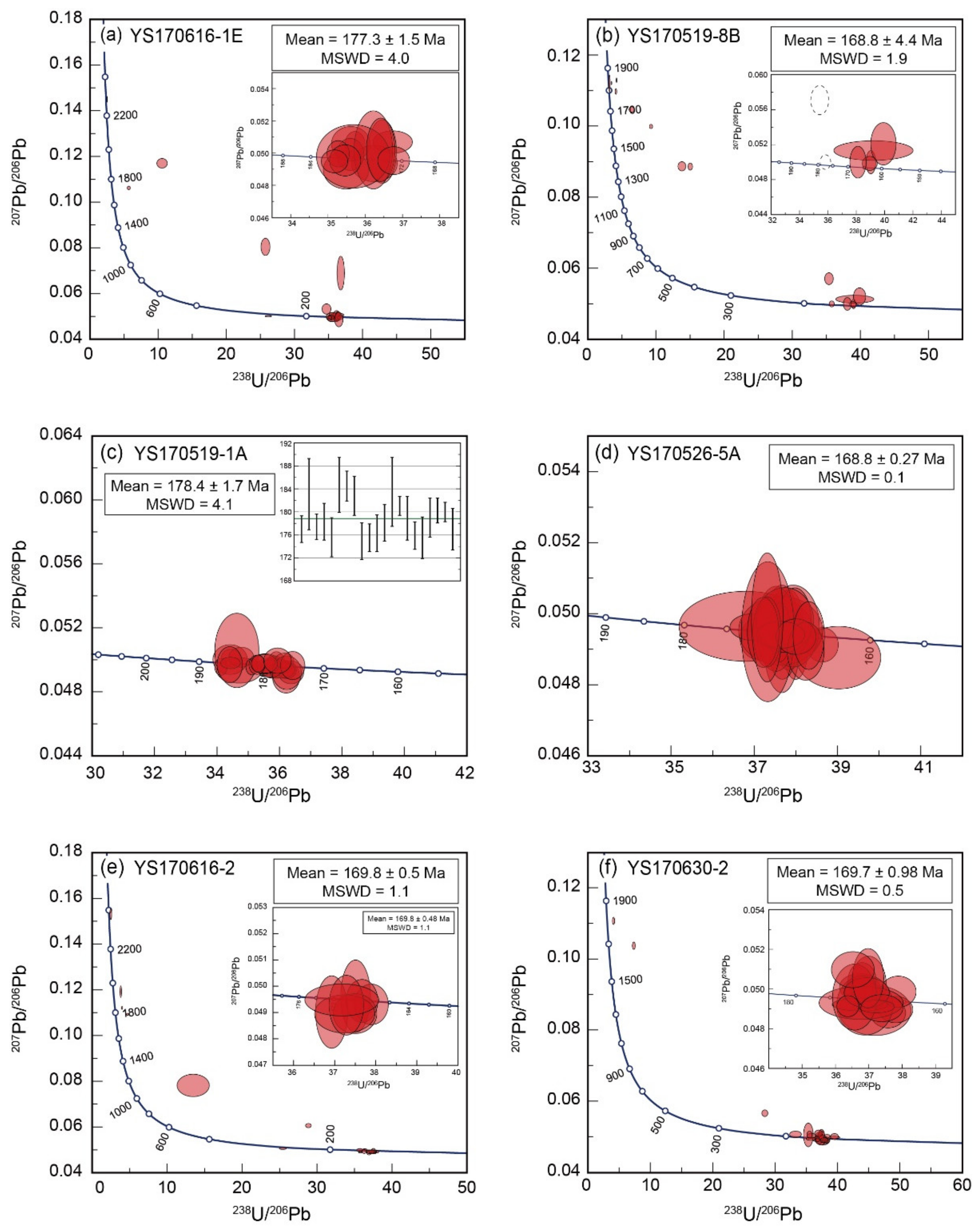
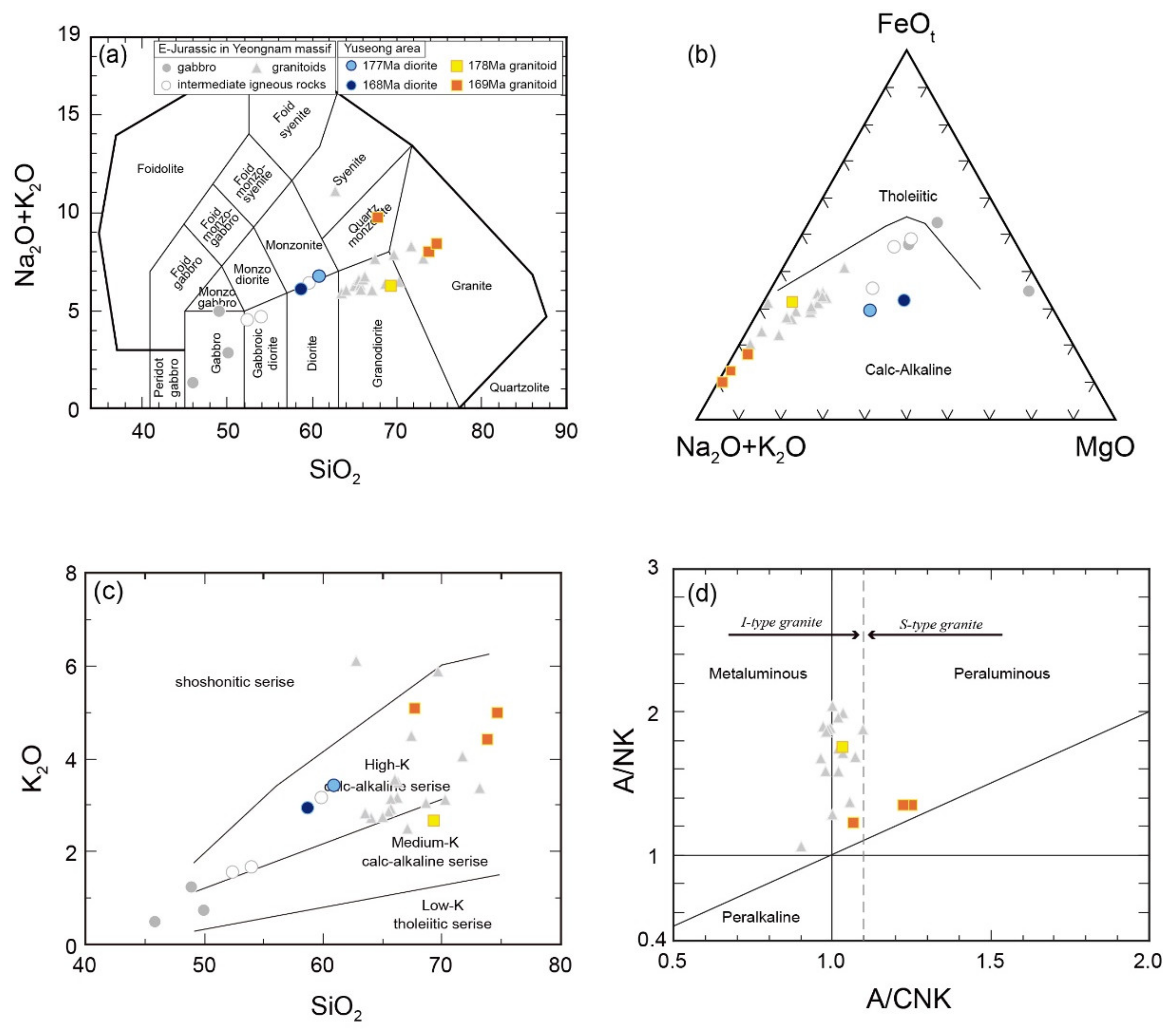
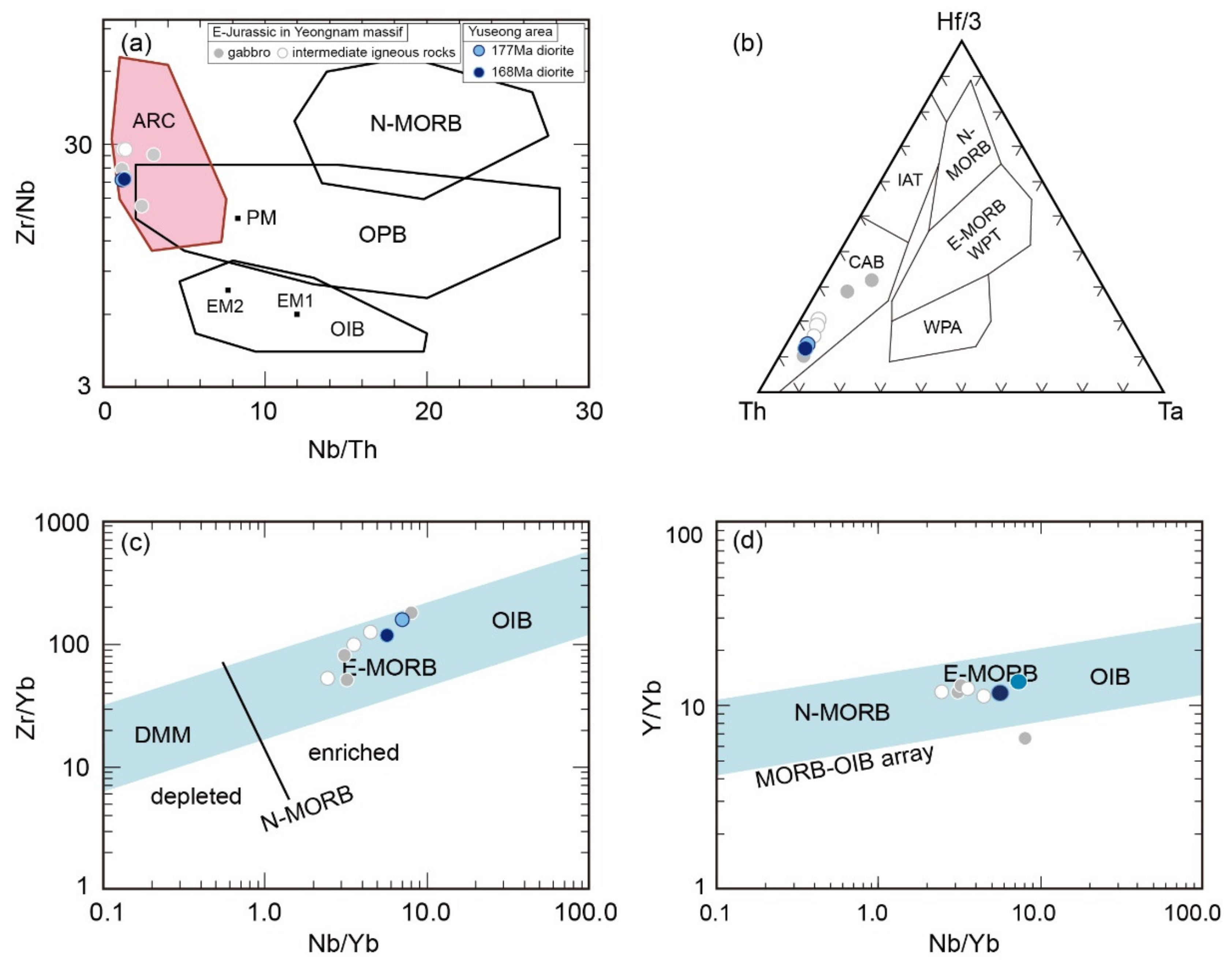
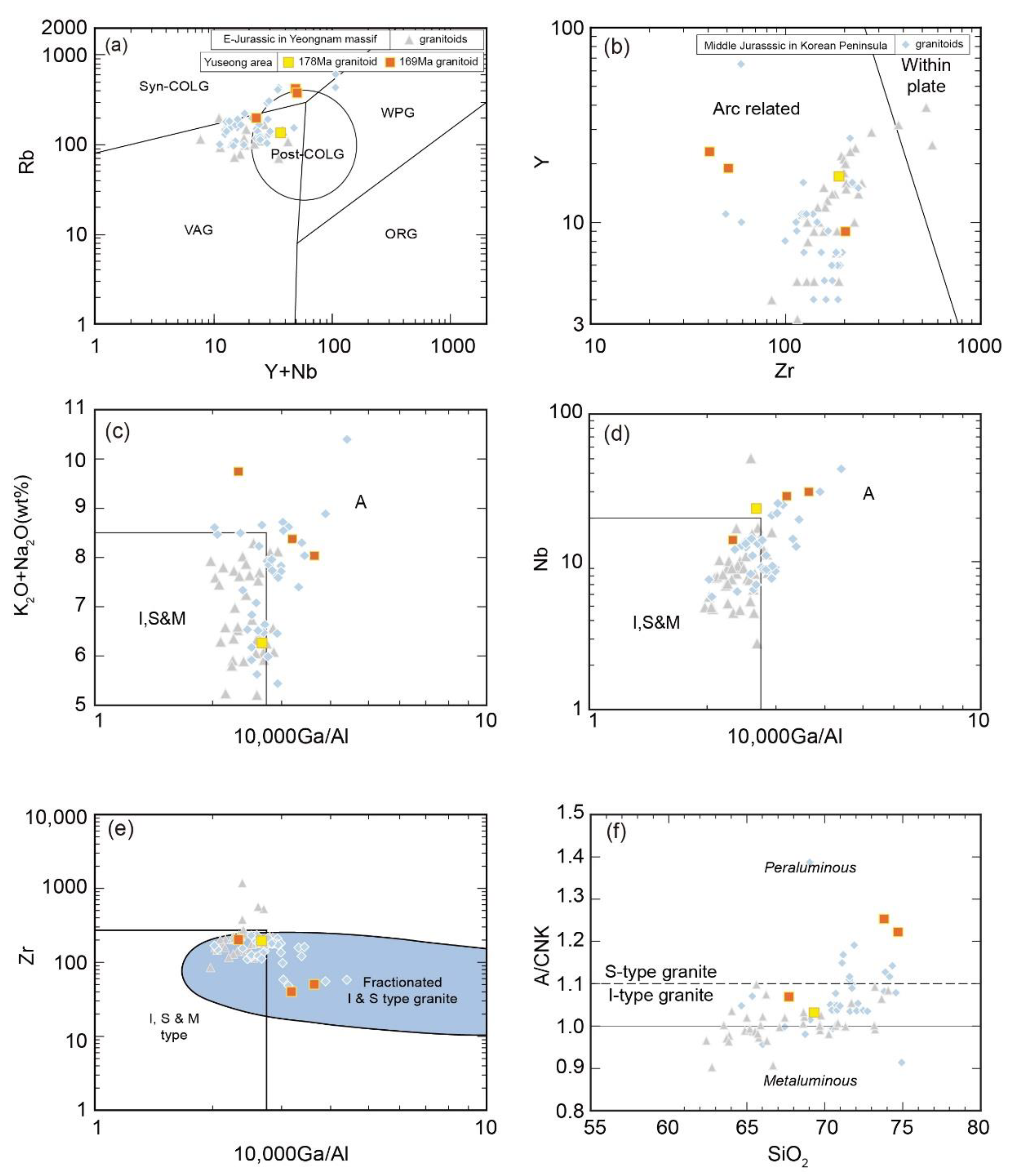
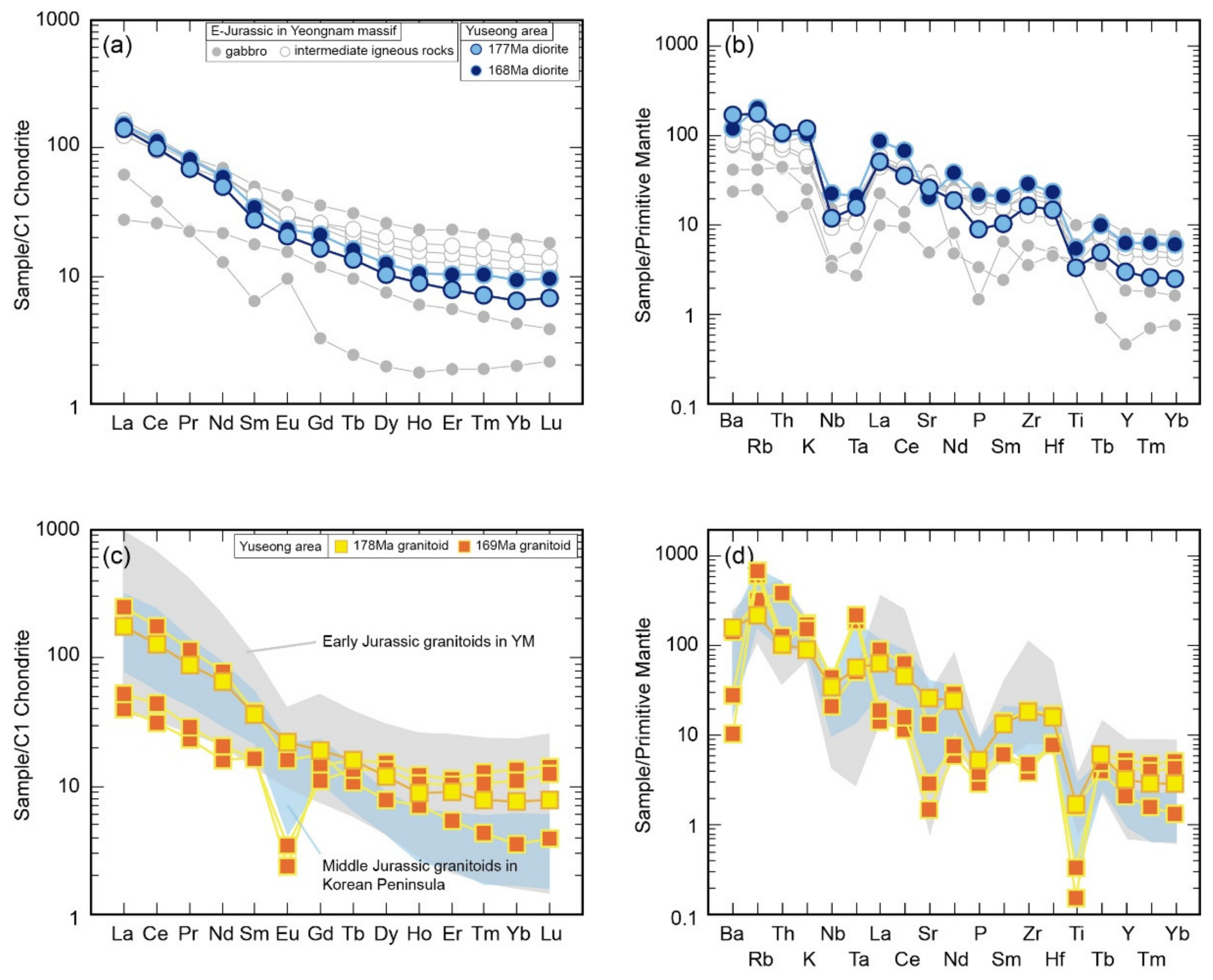
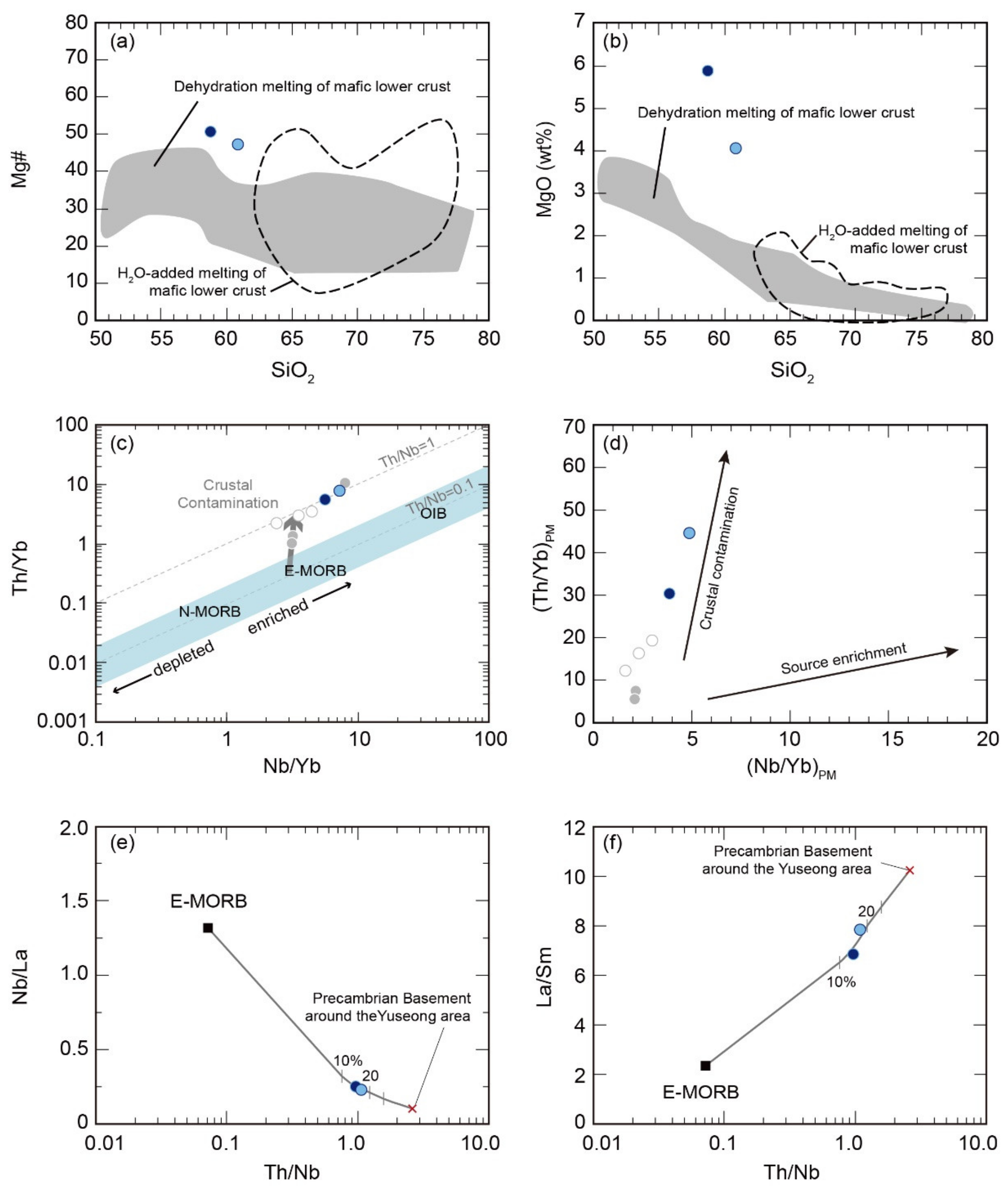
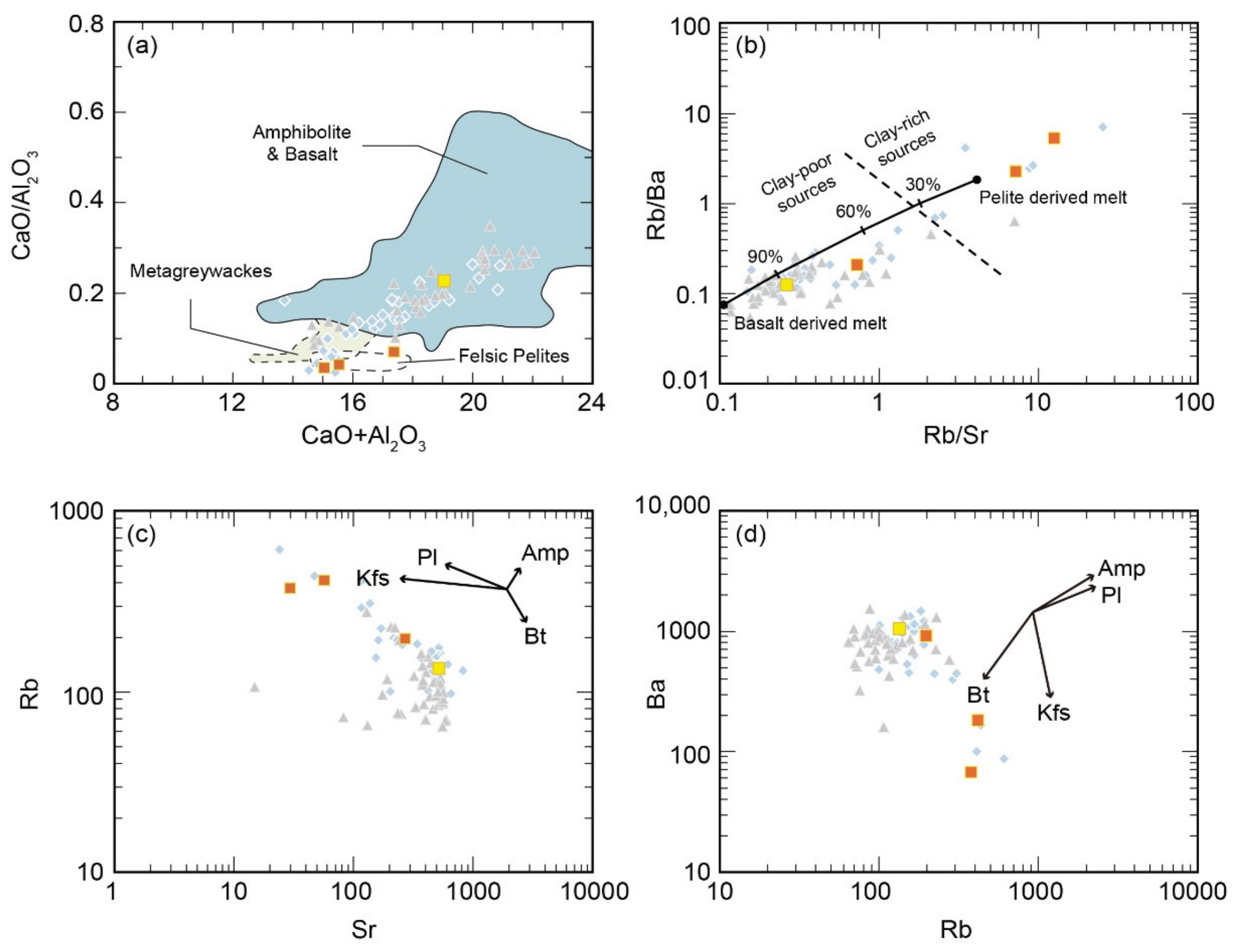

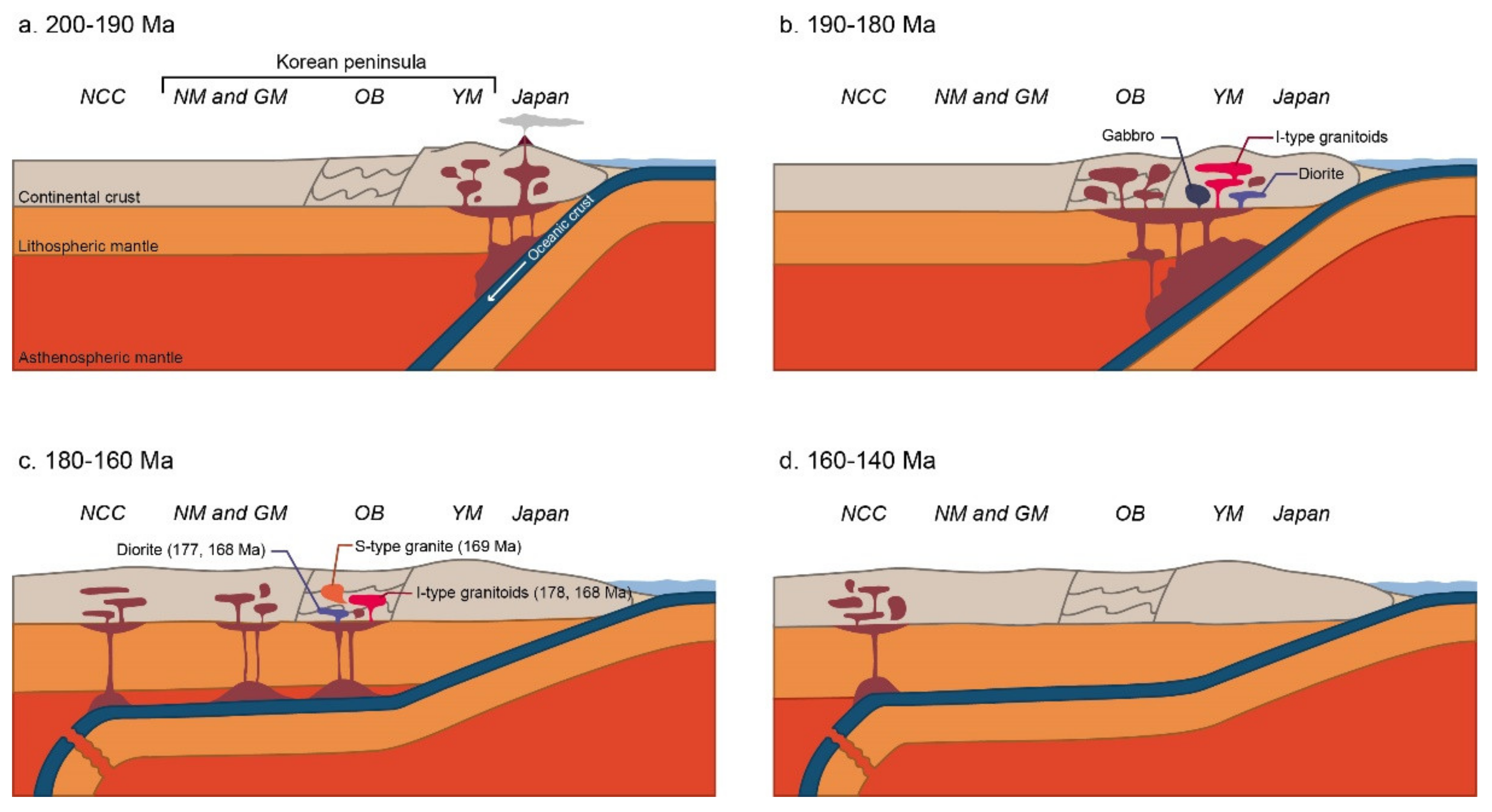
| Rock Type | Diorite | Granitoids | ||||
|---|---|---|---|---|---|---|
| sample | YS170519-8B | YS170616-1B | YS170526-5A | YS170630-2 | YS170616-2 | YS170519-1A |
| Major element (wt%) | ||||||
| SiO2 | 58.72 | 60.87 | 67.72 | 73.83 | 74.69 | 69.30 |
| Al2O3 | 14.99 | 14.79 | 16.26 | 14.56 | 14.86 | 15.56 |
| MnO | 0.09 | 0.08 | 0.03 | 0.12 | 0.05 | 0.06 |
| MgO | 5.86 | 4.04 | 0.43 | 0.10 | 0.09 | 0.68 |
| CaO | 5.65 | 4.63 | 1.11 | 0.49 | 0.65 | 3.44 |
| Fe2O3t | 6.33 | 5.01 | 2.36 | 1.37 | 1.05 | 3.61 |
| Na2O | 3.15 | 3.30 | 4.66 | 3.62 | 3.37 | 3.61 |
| K2O | 2.94 | 3.45 | 5.10 | 4.42 | 5.01 | 2.67 |
| TiO2 | 0.87 | 0.67 | 0.32 | 0.07 | 0.03 | 0.34 |
| P2O5 | 0.24 | 0.19 | 0.10 | 0.08 | 0.06 | 0.11 |
| LOI | 1.55 | 2.83 | 0.86 | 0.83 | 0.55 | 0.60 |
| Total | 100.40 | 99.87 | 98.94 | 99.48 | 100.40 | 99.98 |
| Mg# | 0.51 | 0.47 | 0.17 | 0.08 | 0.09 | 0.17 |
| A/CNK | 0.80 | 0.84 | 1.07 | 1.25 | 1.22 | 1.03 |
| Trace element (ppm) | ||||||
| Sc | 16.00 | 12.00 | 2.00 | 2.00 | 1.00 | 3.00 |
| Cr | 380.00 | 260.00 | 110.00 | 140.00 | 110.00 | <20 |
| Zn | 90.00 | 70.00 | < 30 | 60.00 | 50.00 | 80.00 |
| Ga | 19.00 | 19.00 | 20.00 | 28.00 | 25.00 | 22.00 |
| Rb | 78.00 | 109.00 | 197.00 | 415.00 | 375.00 | 134.00 |
| Sr | 492.00 | 520.00 | 272.00 | 58.00 | 30.00 | 523.00 |
| Y | 17.00 | 13.00 | 9.00 | 19.00 | 23.00 | 14.00 |
| Zr | 189.00 | 172.00 | 202.00 | 51.00 | 41.00 | 197.00 |
| Nb | 9.00 | 8.00 | 14.00 | 30.00 | 28.00 | 23.00 |
| Cs | 2.40 | 1.90 | 3.60 | 12.20 | 6.00 | 2.70 |
| Ba | 945.00 | 1143.00 | 950.00 | 188.00 | 70.00 | 1077.00 |
| La | 36.40 | 33.10 | 58.60 | 12.60 | 9.50 | 41.80 |
| Ce | 69.70 | 61.00 | 108.00 | 27.20 | 19.20 | 78.60 |
| Pr | 7.73 | 6.62 | 10.90 | 2.79 | 2.21 | 8.42 |
| Nd | 28.10 | 23.60 | 36.10 | 9.50 | 7.50 | 30.30 |
| Sm | 5.30 | 4.20 | 5.90 | 2.50 | 2.60 | 5.50 |
| Eu | 1.36 | 1.20 | 0.92 | 0.20 | 0.14 | 1.29 |
| Gd | 4.30 | 3.40 | 3.60 | 2.30 | 3.00 | 3.90 |
| Tb | 0.60 | 0.50 | 0.40 | 0.50 | 0.60 | 0.60 |
| Dy | 3.20 | 2.60 | 2.00 | 3.40 | 3.90 | 3.00 |
| Ho | 0.60 | 0.50 | 0.40 | 0.60 | 0.70 | 0.50 |
| Er | 1.70 | 1.30 | 0.90 | 1.70 | 1.90 | 1.50 |
| Tm | 0.26 | 0.18 | 0.11 | 0.27 | 0.33 | 0.20 |
| Yb | 1.60 | 1.10 | 0.60 | 1.90 | 2.30 | 1.30 |
| Lu | 0.24 | 0.17 | 0.10 | 0.32 | 0.36 | 0.20 |
| Hf | 4.10 | 4.20 | 4.90 | 2.20 | 2.30 | 4.50 |
| Ta | 0.60 | 0.60 | 1.90 | 8.20 | 7.00 | 2.10 |
| Pb | 12.00 | 19.00 | 30.00 | 37.00 | 41.00 | 18.00 |
| Th | 8.80 | 8.80 | 30.60 | 10.30 | 8.00 | 8.40 |
| U | 1.70 | 1.90 | 5.90 | 10.90 | 4.80 | 1.80 |
| Eu/Eu* | 0.87 | 0.97 | 0.61 | 0.25 | 0.15 | 0.85 |
| (Th/Yb)PM | 30.51 | 44.38 | 282.91 | 30.07 | 19.29 | 35.84 |
| (Nb/Yb)PM | 3.77 | 4.87 | 15.64 | 10.58 | 8.16 | 11.86 |
| (La/Yb)N | 15.45 | 20.44 | 66.35 | 4.50 | 2.81 | 21.84 |
| TZr (°C) | - | - | 924.42 | 788.97 | 770.20 | 921.62 |
Publisher’s Note: MDPI stays neutral with regard to jurisdictional claims in published maps and institutional affiliations. |
© 2021 by the authors. Licensee MDPI, Basel, Switzerland. This article is an open access article distributed under the terms and conditions of the Creative Commons Attribution (CC BY) license (https://creativecommons.org/licenses/by/4.0/).
Share and Cite
Lee, S.H.; Oh, C.W.; Jung, S. Jurassic Igneous Activity in the Yuseong Area on the Southern Margin of the Gyeonggi Massif, Korean Peninsula, and Its Implications for the Tectonic Evolution of Northeast Asia during the Jurassic. Minerals 2021, 11, 466. https://doi.org/10.3390/min11050466
Lee SH, Oh CW, Jung S. Jurassic Igneous Activity in the Yuseong Area on the Southern Margin of the Gyeonggi Massif, Korean Peninsula, and Its Implications for the Tectonic Evolution of Northeast Asia during the Jurassic. Minerals. 2021; 11(5):466. https://doi.org/10.3390/min11050466
Chicago/Turabian StyleLee, Seung Hwan, Chang Whan Oh, and Soolim Jung. 2021. "Jurassic Igneous Activity in the Yuseong Area on the Southern Margin of the Gyeonggi Massif, Korean Peninsula, and Its Implications for the Tectonic Evolution of Northeast Asia during the Jurassic" Minerals 11, no. 5: 466. https://doi.org/10.3390/min11050466
APA StyleLee, S. H., Oh, C. W., & Jung, S. (2021). Jurassic Igneous Activity in the Yuseong Area on the Southern Margin of the Gyeonggi Massif, Korean Peninsula, and Its Implications for the Tectonic Evolution of Northeast Asia during the Jurassic. Minerals, 11(5), 466. https://doi.org/10.3390/min11050466






